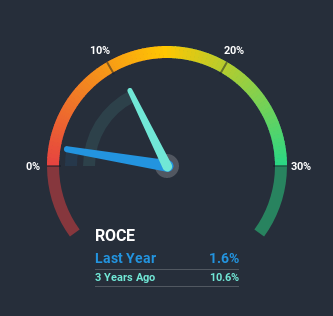- South Korea
- /
- Auto Components
- /
- KOSDAQ:A122350
What Do The Returns On Capital At Samkee Automotive (KOSDAQ:122350) Tell Us?
Finding a business that has the potential to grow substantially is not easy, but it is possible if we look at a few key financial metrics. Amongst other things, we'll want to see two things; firstly, a growing return on capital employed (ROCE) and secondly, an expansion in the company's amount of capital employed. Put simply, these types of businesses are compounding machines, meaning they are continually reinvesting their earnings at ever-higher rates of return. In light of that, when we looked at Samkee Automotive (KOSDAQ:122350) and its ROCE trend, we weren't exactly thrilled.
Understanding Return On Capital Employed (ROCE)
For those that aren't sure what ROCE is, it measures the amount of pre-tax profits a company can generate from the capital employed in its business. Analysts use this formula to calculate it for Samkee Automotive:
Return on Capital Employed = Earnings Before Interest and Tax (EBIT) ÷ (Total Assets - Current Liabilities)
0.016 = ₩3.6b ÷ (₩429b - ₩205b) (Based on the trailing twelve months to June 2020).
So, Samkee Automotive has an ROCE of 1.6%. Ultimately, that's a low return and it under-performs the Auto Components industry average of 4.3%.
Check out our latest analysis for Samkee Automotive

While the past is not representative of the future, it can be helpful to know how a company has performed historically, which is why we have this chart above. If you want to delve into the historical earnings, revenue and cash flow of Samkee Automotive, check out these free graphs here.
What Does the ROCE Trend For Samkee Automotive Tell Us?
When we looked at the ROCE trend at Samkee Automotive, we didn't gain much confidence. Around five years ago the returns on capital were 14%, but since then they've fallen to 1.6%. Although, given both revenue and the amount of assets employed in the business have increased, it could suggest the company is investing in growth, and the extra capital has led to a short-term reduction in ROCE. If these investments prove successful, this can bode very well for long term stock performance.
On a side note, Samkee Automotive's current liabilities are still rather high at 48% of total assets. This effectively means that suppliers (or short-term creditors) are funding a large portion of the business, so just be aware that this can introduce some elements of risk. Ideally we'd like to see this reduce as that would mean fewer obligations bearing risks.In Conclusion...
While returns have fallen for Samkee Automotive in recent times, we're encouraged to see that sales are growing and that the business is reinvesting in its operations. And there could be an opportunity here if other metrics look good too, because the stock has declined 31% in the last five years. As a result, we'd recommend researching this stock further to uncover what other fundamentals of the business can show us.
One more thing: We've identified 3 warning signs with Samkee Automotive (at least 2 which are potentially serious) , and understanding these would certainly be useful.
For those who like to invest in solid companies, check out this free list of companies with solid balance sheets and high returns on equity.
If you decide to trade Samkee Automotive, use the lowest-cost* platform that is rated #1 Overall by Barron’s, Interactive Brokers. Trade stocks, options, futures, forex, bonds and funds on 135 markets, all from a single integrated account. Promoted
New: Manage All Your Stock Portfolios in One Place
We've created the ultimate portfolio companion for stock investors, and it's free.
• Connect an unlimited number of Portfolios and see your total in one currency
• Be alerted to new Warning Signs or Risks via email or mobile
• Track the Fair Value of your stocks
This article by Simply Wall St is general in nature. It does not constitute a recommendation to buy or sell any stock, and does not take account of your objectives, or your financial situation. We aim to bring you long-term focused analysis driven by fundamental data. Note that our analysis may not factor in the latest price-sensitive company announcements or qualitative material. Simply Wall St has no position in any stocks mentioned.
*Interactive Brokers Rated Lowest Cost Broker by StockBrokers.com Annual Online Review 2020
Have feedback on this article? Concerned about the content? Get in touch with us directly. Alternatively, email editorial-team@simplywallst.com.
About KOSDAQ:A122350
Samkee
Engages in the manufacturing and selling of automobile die-cast parts, aluminum smelting, and aluminum alloy production in South Korea, rest of Asia, Europe, and North America.
Slightly overvalued with very low risk.
Market Insights
Community Narratives



